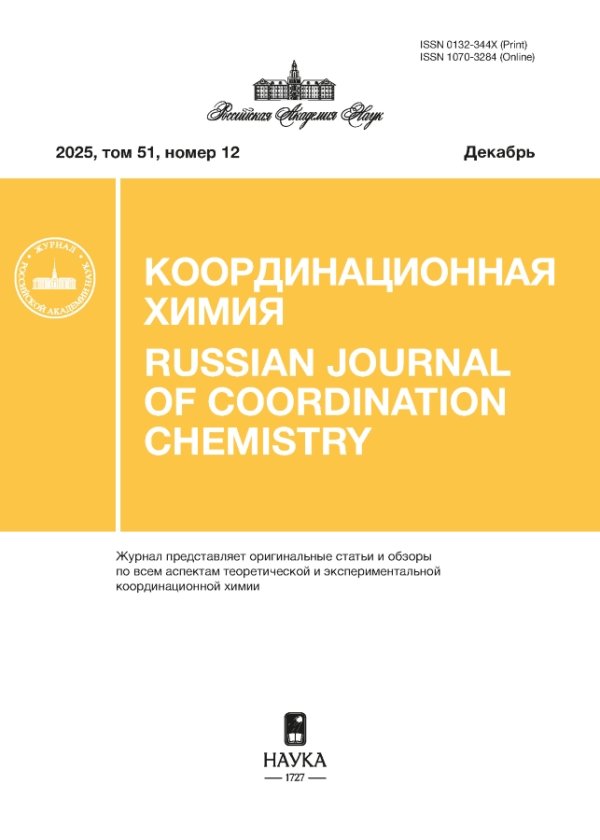Vol 49, No 1 (2023)
Articles
Coordination Compounds in Devices of Molecular Spintronics
Abstract
Spintronics, being one of the youngest fields of microelectronics, is applied already for several decades to enhance the efficiency of components of computer equipment and to develop units of quantum computer and other electronic devices. The use of molecular material layers in a spintronic device makes it possible to substantially deepen the understanding of the spin transport mechanisms and to form foundation for a new trend at the nexus of physics and chemistry: molecular spintronics. Since the appearance of this trend, various coordination compounds, including semiconductors, single-molecule magnets, complexes with spin transitions, and metal-organic frameworks, are considered as molecular materials of spintronic devices with diverse unusual characteristics imparted by these materials. Specific features of using the earlier described representatives of the listed classes of compounds or their analogs, which are still “kept on the shelves” in chemical laboratories, for manufacturing polyfunctional devices of molecular spintronics are briefly reviewed.
 3-12
3-12


Species of Gold(III) Binding by Binuclear Zinc Dipropyldithiocarbamate: Supramolecular Self-Organization and Thermal Behavior of Ionic Complexes [Au(S2CNPr2)2]2[ZnCl4] and [Au(S2CNPr2)2]2[AuCl4][AuCl2]
Abstract
The reaction of binuclear zinc dipropyldithiocarbamate [Zn2{S2CN(C3H7)2}4] with an AuCl3/2 М HCl solution is studied. The double ionic complex [Au{S2CN(C3H7)2}2]2[ZnCl4] (I) is identified as the main species of gold(III) binding in the heterogeneous system under study and is characterized by 13С and 15N CP-MAS NMR spectroscopy. Single crystals of heterovalent compound [Au{S2CN(C3H7)2}2]2[AuCl4][AuCl2] (II) are sampled as a by-product. The crystal and supramolecular structures of complexes I and II are determined by the direct XRD method (CIF files CCDC nos. 2159171 and 2159170, respectively). The self-organization of the complex pseudopolymeric structures of compounds I and II are shown to be due to the binding of ionic structural units by secondary nonvalent interactions Au⋅⋅⋅S and S⋅⋅⋅Cl and hydrogen bonds C–H⋅⋅⋅Cl. The thermal behavior of the complexes is studied by simultaneous thermal analysis (STA), and the quantitative regeneration of bound gold (I and II) with the partial transformation of released ZnCl2 to ZnS (I) is found.
 13-26
13-26


Study of the Reduction of Cobalt(III) Complexes by In Situ NMR Spectroscopy
Abstract
An approach for monitoring the redox activation of drug delivery in cobalt(III) complexes by in situ NMR spectroscopy is proposed. The reduction of the heteroleptic cobalt(III) complexes containing the 6,7-dihydroxycoumarin molecule applied as a model drug is studied using the proposed approach. The replacement of the bipyridine ligand in the cobalt(III) complex by phenanthroline considerably increases the redox-activated release rate of the drug.
 27-35
27-35


Rhenium(V) Tris(pyrazolyl)borate Complexes as Ligands in Square Planar Palladium and Platinum Complexes
Abstract
The reactions of TpReO(SnC3H7)2 (Tp = tris(pyrazolyl)borate anion) with acetonitrile complexes PdCl2(MeCN)2 and PtI2(MeCN)2 in toluene solutions resulted in the formation of new heterometallic rhenium complexes TpReO(µ-SnC3H7)2MX2 (MX2 = PdCl2 (I), MX2 = PtI2 (II)). A similar complex TpReO(µ-SnC3H7)2PdI2 (III) was formed either on treatment of I with NaI in dichloromethane or in the reaction of TpReO(SnC3H7)2 with a suspension of PdI2 in toluene. Complexes I–III were characterized by IR and NMR spectroscopy and by X-ray diffraction (CCDC nos. 2172225–2172227).
 36-43
36-43


New Binuclear Copper(II) Complex Based on 1,2-Bis(2-(4,4,4-trifluoro-1,3-dioxobutyl)phenoxyethane: Synthesis and Structure
Abstract
New binuclear complex 1,2-bis[2-(4,4,4-trifluoro-1-hydroxy-3-oxobut-1-enyl)phenoxy]ethanedi(dimethylformamide)dicopper(II) is synthesized, and its structure is studied by X-ray diffraction (XRD) (CIF file CCDC no. 2179252). A crystal of the complex is formed by centrosymmetric Cu2L2(DMF)2 molecules in which the coordination environment of each metallocenter is a distorted square pyramid, and the whole molecule is a metallomacrocycle containing the calixarene-like cavity. Its size is determined the distance between the Cu…Cu metallocenters (7.699 Å) and the distance between the planes of the opposite phenyl radicals in the cis position (8.200–8.323 Å). The cavity is a parallelogram. The carcass-type binuclear structure is formed due to an increase in the denticity of the ligand via the formation of the bis(triketone)-like structure that weakens the donor character of both functional groups of the β-diketone fragment.
 44-50
44-50


Tetrapyridineplatinum(II) Carboxylates: Synthesis and Crystal Structure
Abstract
A series of mono- and bimetallic cation-anionic complexes based on the [PtPy4]2+ cation with different single-charge anions of carboxylic acids (RCOO–) is synthesized and structurally characterized. A synthetic approach to the preparation of tetrapyridineplatinum complexes [PtPy4]2+ soluble in polar solvents from available reagents is developed. The reaction of tetrapyridineplatinum dichloride [PtPy4](Cl)2 with silver acetate or trifluoroacetate affords compounds [PtPy4](OOCMe)2·6H2O (I) and [PtPy4](OOCCF3)2· 2H2O (II) in the form of crystalline hydrates (CIF files CCDC nos. 2161100 and 2161101, respectively) in high yields. Other carboxylates can be prepared by the treatment of compound I with an excess of a stronger acid, for example, trifluoroacetic acid, with the formation of the corresponding complex trifluoroacetate [PtPy4](OOCCF3)2·4CF3COOH (IIa) (CIF file CCDC no. 2161102). Another method consists of the displacement of acetic acid with an excess of a lowly volatile acid, for example, pivalic acid, when [PtPy4](Piv)2· 5HPiv (III) is formed from the acid melt, and solvatomorph [PtPy4](Piv)2·4HPiv·3C6H12 (IIIa) (CIF files CCDC nos. 2161103 and 2161104, respectively) is formed in a cyclohexane medium. Heteroanionic heterometallic complex [PtPy4](OOCFc)(OOCMe) (IV) (CIF file CCDC no. 2161105) is shown to be formed by the reaction of complex I with ferrocenecarboxylic acid under mild conditions.
 51-63
51-63


Поправка
 64
64












